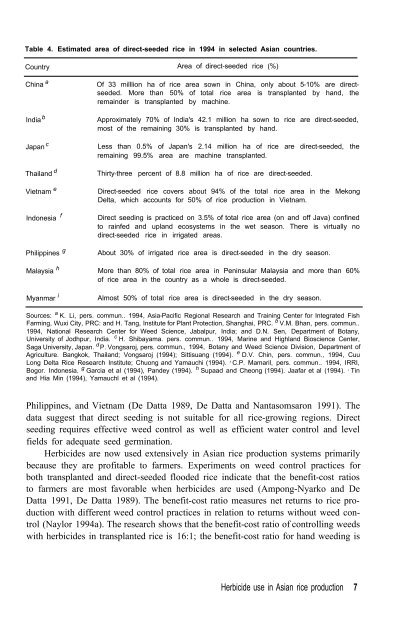HERBICIDES in Asian rice - IRRI books - International Rice ...
HERBICIDES in Asian rice - IRRI books - International Rice ...
HERBICIDES in Asian rice - IRRI books - International Rice ...
Create successful ePaper yourself
Turn your PDF publications into a flip-book with our unique Google optimized e-Paper software.
Table 4. Estimated area of direct-seeded <strong>rice</strong> <strong>in</strong> 1994 <strong>in</strong> selected <strong>Asian</strong> countries.<br />
Country<br />
Ch<strong>in</strong>a a<br />
India b<br />
Japan c<br />
Thailand d<br />
Vietnam e<br />
Indonesia f<br />
Philipp<strong>in</strong>es g<br />
Malaysia h<br />
Myanmar i<br />
Area of direct-seeded <strong>rice</strong> (%)<br />
Of 33 milllion ha of <strong>rice</strong> area sown <strong>in</strong> Ch<strong>in</strong>a, only about 5-10% are directseeded.<br />
More than 50% of total <strong>rice</strong> area is transplanted by hand, the<br />
rema<strong>in</strong>der is transplanted by mach<strong>in</strong>e.<br />
Approximately 70% of India's 42.1 million ha sown to <strong>rice</strong> are direct-seeded,<br />
most of the rema<strong>in</strong><strong>in</strong>g 30% is transplanted by hand.<br />
Less than 0.5% of Japan's 2.14 million ha of <strong>rice</strong> are direct-seeded, the<br />
rema<strong>in</strong><strong>in</strong>g 99.5% area are mach<strong>in</strong>e transplanted.<br />
Thirty-three percent of 8.8 million ha of <strong>rice</strong> are direct-seeded.<br />
Direct-seeded <strong>rice</strong> covers about 94% of the total <strong>rice</strong> area <strong>in</strong> the Mekong<br />
Delta, which accounts for 50% of <strong>rice</strong> production <strong>in</strong> Vietnam.<br />
Direct seed<strong>in</strong>g is practiced on 3.5% of total <strong>rice</strong> area (on and off Java) conf<strong>in</strong>ed<br />
to ra<strong>in</strong>fed and upland ecosystems <strong>in</strong> the wet season. There is virtually no<br />
direct-seeded <strong>rice</strong> <strong>in</strong> irrigated areas.<br />
About 30% of irrigated <strong>rice</strong> area is direct-seeded <strong>in</strong> the dry season.<br />
More than 80% of total <strong>rice</strong> area <strong>in</strong> Pen<strong>in</strong>sular Malaysia and more than 60%<br />
of <strong>rice</strong> area <strong>in</strong> the country as a whole is direct-seeded.<br />
Almost 50% of total <strong>rice</strong> area is direct-seeded <strong>in</strong> the dry season.<br />
Sources: a K. Li, pers. commun.. 1994, Asia-Pacific Regional Research and Tra<strong>in</strong><strong>in</strong>g Center for Integrated Fish<br />
Farm<strong>in</strong>g, Wuxi City, PRC: and H. Tang, Institute for Plant Protection, Shanghai, PRC. b V.M. Bhan, pers. commun..<br />
1994, National Research Center for Weed Science, Jabalpur, India; and D.N. Sen, Department of Botany,<br />
University of Jodhpur, India. c H. Shibayama. pers. commun.. 1994, Mar<strong>in</strong>e and Highland Bioscience Center,<br />
Saga University, Japan. d P. Vongsaroj, pers. commun., 1994, Botany and Weed Science Division, Department of<br />
Agriculture. Bangkok, Thailand; Vongsaroj (1994); Sittisuang (1994). e D.V. Ch<strong>in</strong>, pers. commun., 1994, Cuu<br />
Long Delta <strong>Rice</strong> Research Institute; Chuong and Yamauchi (1994). f C.P. Mamaril, pers. commun.. 1994, <strong>IRRI</strong>,<br />
Bogor. Indonesia. g Garcia et al (1994), Pandey (1994). h Supaad and Cheong (1994). Jaafar et al (1994). i T<strong>in</strong><br />
and Hia M<strong>in</strong> (1994), Yamauchl et al (1994).<br />
Philipp<strong>in</strong>es, and Vietnam (De Datta 1989, De Datta and Nantasomsaron 1991). The<br />
data suggest that direct seed<strong>in</strong>g is not suitable for all <strong>rice</strong>-grow<strong>in</strong>g regions. Direct<br />
seed<strong>in</strong>g requires effective weed control as well as efficient water control and level<br />
fields for adequate seed germ<strong>in</strong>ation.<br />
Herbicides are now used extensively <strong>in</strong> <strong>Asian</strong> <strong>rice</strong> production systems primarily<br />
because they are profitable to farmers. Experiments on weed control practices for<br />
both transplanted and direct-seeded flooded <strong>rice</strong> <strong>in</strong>dicate that the benefit-cost ratios<br />
to farmers are most favorable when herbicides are used (Ampong-Nyarko and De<br />
Datta 1991, De Datta 1989). The benefit-cost ratio measures net returns to <strong>rice</strong> production<br />
with different weed control practices <strong>in</strong> relation to returns without weed control<br />
(Naylor 1994a). The research shows that the benefit-cost ratio of controll<strong>in</strong>g weeds<br />
with herbicides <strong>in</strong> transplanted <strong>rice</strong> is 16:1; the benefit-cost ratio for hand weed<strong>in</strong>g is<br />
Herbicide use <strong>in</strong> <strong>Asian</strong> <strong>rice</strong> production 7

















